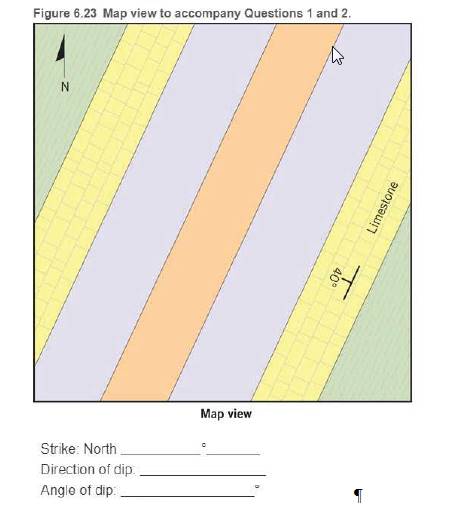
Refer to Figure 6.23 to describe the strike and dip of the limestone layer

Introduction:
The sedimentary rocks are formed from sediments that are transported by running water to the shallow seas, and over time they undergo processes like compression, compaction, burial, and cementation in the deep crust to form sedimentary rocks.
Answer to Problem 1LR
Correct answer:
The strike in the given limestone layer is 25 ° East. The direction of dip is 180 °, and the angle of dip is 40°.
Explanation of Solution
The method of calculating the strike, angle of dip, and direction of dip includes the measurement of strike and dip present on the rock layers or planar features. The strike in limestone is defined as the compass direction that is relative to north. It is constructed of the line formed by the intersection of a rock layer. The strike of the limestone layer is 25 ° East, the direction of dip is 180 °, and the angle of dip is 40°.
Want to see more full solutions like this?
Chapter 6 Solutions
Masteringgeology With Pearson Etext -- Valuepack Access Card -- For Applications And Investigations In Earth Science
Additional Science Textbook Solutions
Campbell Biology: Concepts & Connections (9th Edition)
Physics for Scientists and Engineers: A Strategic Approach, Vol. 1 (Chs 1-21) (4th Edition)
Brock Biology of Microorganisms (15th Edition)
Campbell Biology (11th Edition)
Chemistry: An Introduction to General, Organic, and Biological Chemistry (13th Edition)
Human Biology: Concepts and Current Issues (8th Edition)
- how can the addition of nutrients such as nitrates and phosphates result in a reduction of the amount of dissolved oxygen in the water?arrow_forwardCongratulations! You have just been selected to be the ruler of China with absolute power! What are the first five things that you would do to protect the environment and human health from water pollution (not other types of pollution)?arrow_forwardWhy is storm water management more of a problem in an urban area than in a rural area?arrow_forward
- Think about natural resource management topics. Which topic or topics, if any, are of most interest to you?arrow_forwardWeathering, erosion, transportation, deposition Compaction, cementation, chemical actions (Lithification) Sediment Igneous rocks Cooling, solidification (Crystallization) Magma From mantle New material Melting added from depth (Metam Heat, inter Sedimentary rocks Metamorphic rocksarrow_forwardDiscussion Question: Essentials of Geography A+ Chapter 1 does a nice job introducing the Physical Earth Sciences with the traditional scientific methods and systems. However, Physical Geography exemplifies understanding spatial patterns. For example, we could research an area's cases of West Nile Virus using a table filled with location and number of deaths and it would be useful. However, an even better way to look at the information in order to search for an underlying pattern and an explanation would be to map the data. For the Chapter 1 Discussion, find a thematic map from your house, the Newspaper, the Internet, the textbook, or wherever you find one! Be sure to include the source such that any of us can get our hands on the same information/map. First DESCRIBE the patterns that you see. Then, INTERPRET the reasons for the pattern. For example,the figures above and below are maps with information plotted. Remember, descriptions are not arguable. Descriptions are factual…arrow_forward
 Applications and Investigations in Earth Science ...Earth ScienceISBN:9780134746241Author:Edward J. Tarbuck, Frederick K. Lutgens, Dennis G. TasaPublisher:PEARSON
Applications and Investigations in Earth Science ...Earth ScienceISBN:9780134746241Author:Edward J. Tarbuck, Frederick K. Lutgens, Dennis G. TasaPublisher:PEARSON Exercises for Weather & Climate (9th Edition)Earth ScienceISBN:9780134041360Author:Greg CarbonePublisher:PEARSON
Exercises for Weather & Climate (9th Edition)Earth ScienceISBN:9780134041360Author:Greg CarbonePublisher:PEARSON Environmental ScienceEarth ScienceISBN:9781260153125Author:William P Cunningham Prof., Mary Ann Cunningham ProfessorPublisher:McGraw-Hill Education
Environmental ScienceEarth ScienceISBN:9781260153125Author:William P Cunningham Prof., Mary Ann Cunningham ProfessorPublisher:McGraw-Hill Education Earth Science (15th Edition)Earth ScienceISBN:9780134543536Author:Edward J. Tarbuck, Frederick K. Lutgens, Dennis G. TasaPublisher:PEARSON
Earth Science (15th Edition)Earth ScienceISBN:9780134543536Author:Edward J. Tarbuck, Frederick K. Lutgens, Dennis G. TasaPublisher:PEARSON Environmental Science (MindTap Course List)Earth ScienceISBN:9781337569613Author:G. Tyler Miller, Scott SpoolmanPublisher:Cengage Learning
Environmental Science (MindTap Course List)Earth ScienceISBN:9781337569613Author:G. Tyler Miller, Scott SpoolmanPublisher:Cengage Learning Physical GeologyEarth ScienceISBN:9781259916823Author:Plummer, Charles C., CARLSON, Diane H., Hammersley, LisaPublisher:Mcgraw-hill Education,
Physical GeologyEarth ScienceISBN:9781259916823Author:Plummer, Charles C., CARLSON, Diane H., Hammersley, LisaPublisher:Mcgraw-hill Education,





